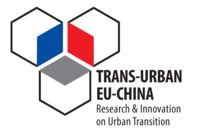
TRANS-URBAN-EU-CHINA
Transition towards urban sustainability through socially integrative cities in the EU and in China
Dynamic balance of farmland occupation and reclamation
1. Purpose(s)
Paralleling with land quota system, another instrument/regulation for keeping dynamic balance between farmland occupation and reclamation has been introduced and implemented in China since 1997 in order to further protect the farmland against the fast urban development and industrial expansion. This tool contributes to maintain the total amount of farmland of 1.865 billion mu (about 12,433,333 ha) for the grain security of China, an assumed red line for country’s survival. It strictly requires that the same amount of farmland is compensated through reclamation somewhere else once the farmland is occupied either by urban growth or industrial projects. Principally, the dynamic balance should be carried out within the same province, i.e. each province has the responsibility to keep its own dynamic balance by reclaiming new farmland within their territory.
Key Words: farmland occupation, farmland reclamation, dynamic balance of farmland occupation and reclamation
2. Relevance and Impact
The intention of this instrument is to protect the possible rapid loss of farmland in China due to rapid urbanization for securing the food supply and safety in the country in long term, while spatially, to a certain degree, to protect the interest of farmers in urban fringe areas through setting barriers for farmland conversion induced by urban expansion.
Related to the land quota system, the dynamic balance of farmland occupation and reclamation is also a well-known instrument applied in China for nearly two decades. The implementation of this instrument is generally effective in reducing the pace of farmland loss in China. However, the rigid implementation of the instrument could result in the lower land use efficiency in urban fringe areas where mosaic type land use pattern usually can be prevailing. This issue has been well addressed in various deliverables in this research project
Two immediate problems occurred in the implementation of the regulation. Firstly, the newly reclaimed farmland has lower land quality for farming compared to the occupied ones, which usually is located in city periphery with fertile soil. Secondly, it is simply impossible for provincial level cities (currently four in China, i.e. Beijing, Shanghai, Tianjin and Chongqing) to meet this requirement given their limited territory as a province level administration and their high dynamics in attracting economic activities and in-flowed population. To address the incurred problems and challenges, the regulation has been adjusted in the process of practice. Three stages of adjustment can be identified and seen in the past two decades. The first stage was in the period of 1997 to 2003, when the quantitative balance was emphasized as the initial phase applying the new instrument. 2004 to 2017 was the second stage when qualitative balance was introduced and implemented, i.e. a same scope of quality land need to be compensated either by the same amount of quality land or by larger amounts of land to be reclaimed when the new land has lower quality. Since 2017, the ecologic effect of land has been included into consideration in the regulation. Irrigated farmland played an additional ecologic function similar as wetland and therefore, stage three of the regulation required a dynamic balance incorporating the factors quantity, quality and ecologic function at same time, keeping the dynamic balance of farmland occupation and reclamation. Furthermore, in the third stage, a more flexible regulation was introduced that allowed these provincial level cities and those provinces with small territory but strong economic and urbanization momentum to keep their balance through purchasing reclaimed land from other provinces under the supervision and permission of national government. This trans-provincial balance approach can also be applied to those national key projects which may need to occupy extra and large amount of farmland within certain cities or province.
3. Strenghts
The strength of the regulation is to effectively protect the farmland for grain security in China and meanwhile provide enough land resources for the fast industrialization and urbanization growth. At the same time the transfer of land development rights help rural areas with large potential for land reclamation to get more financial support for enhancing their public services. To a less extent, the instrument can also deepen the urban-rural integration within the metropolitan regions.
4. Weaknesses
The operation of the instrument requires well-coordinated databases and a monitoring of the implementation action to make sure the compensation of occupied farmland through reclamation is carried out. Therefore, the transaction cost for operating the instrument is very high.
5. Good practice examples
A report from Jiujing city (map), Jiangxi province (Jiujing daily) shows that since 2017 (the third stage of the implementation), the city has achieved great success in applying the instrument into its urban development. For example 100,000 mu farmland was reclaimed in the last two years, which provide enough land for its own city growth, but also extra farmland for transferring to other cities or metropolitan regions.
6. References
XIAO YUAN & Zhao JINHUA. 2015. Fixing China’s distorted urban land quota system. In Paulson Policy Memorandum. Chicago, IL: The Paulson Institute. Available at: http://www.paulsoninstitute.org/wp-content/uploads/2017/01/PPM_Land-Quotas_Xiao-and-Zhao_English_R.pdf [Accessed: 25.01.2021].
Geng, L., Huang, H., & He, Y. (2016). Evolution and Prospect for Balance of Cultivated Land’s Occupation-Compensation System in China. Journal of Anhui Agricultural Sciences, 44(07), 231–235. (耿丽娟,黄宏胜,何亚芬.中国耕地占补平衡制度的演变与展望[J].安徽农业科学,2016,44(07):231-235.)
Liu, J. (2018). The trans-provincial channel opened for implementing the balance of farmland occupation and reclamation. Insight China, No.341(12), 28–29. doi.org/CNKI:SUN:CHXK.0.2018-12-014 (刘建华.耕地占补平衡“跨省调剂”通道打开[J].小康,2018(12):28-2).
Yu, X., & Zhu, X. (2020, August 13). The implementation of balance of farmland occupation and reclamation in Jiujiang city is powerful and effective. Jiujiang Daily. http://jjrb.jjxw.cn/html/2020-08/13/content_85762_12221361.htm (九江日报,2020年8月13日,我市耕地占补平衡工作有力有效)
Jiujiang Daily, 2020/8/13, The implementation of balance of farmland occupation and reclamation is powerful and effective, http://finance.eastmoney.com/a/202008131593308394.html (九江日报,2020年8月 13日, 我市耕地占补平衡⼯作有⼒有效).
7. Author(s) of the article
Jianming Cai